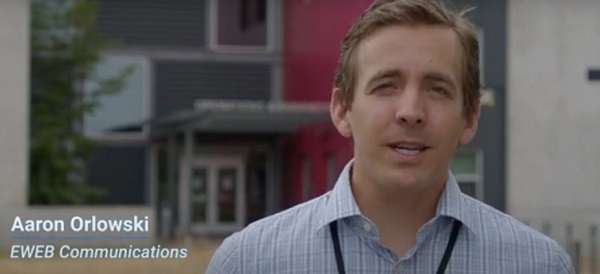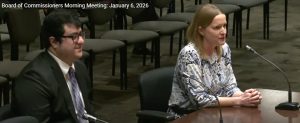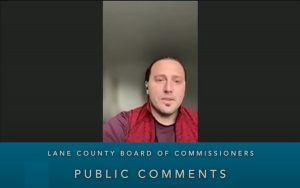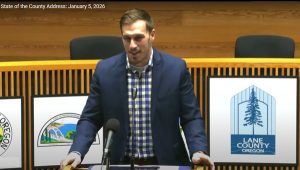EWEB prepares for rising energy demand as weekend heat wave arrives
7 min read
from Aaron Orlowski, Eugene Water and Electric Board, and staff reports
With daily high temperatures forecast to surpass 100 degrees this weekend, EWEB is preparing for rising electricity demand as air conditioning units across Eugene struggle to keep pace with the oppressive heat.
The heat wave is the first volley in what will be a hotter-than-normal summer. For the rest of July, temperatures will be above average across much of the country, including the Pacific Northwest, according to the National Oceanic and Atmospheric Administration (NOAA).
If there are outages or other needs, our crews will be ready to respond. At this point, we don’t anticipate needing to activate emergency protocols.
There are no planned public safety power shutoffs (PSPS) at this time. A PSPS is implemented due to fire danger and the purpose is to prevent fires from starting if trees blow down onto power lines.
On the energy supply side, EWEB is confident we have sufficient energy to get through this heat wave. It helps tremendously that it’s early summer and reservoirs are full – both at EWEB’s hydropower projects and at federally managed hydropower projects on the Columbia River. But the situation might be different in late August when reservoirs have been drawn down.
At this point, we don’t plan to issue a request for the community to conserve energy. However, community members can still play their part to reduce energy use at peak times in the late afternoon and early evening by adjusting the settings on their air conditioning units a few degrees higher. They can also delay the use of major appliances until overnight or the early morning hours, when energy demand will be lower. If you have an electric vehicle, definitely delay charging it until overnight.
EWEB ensures a reliable supply of electricity
EWEB has detailed procedures to always ensure a reliable supply of electricity. In real time, EWEB monitors overall customer demand and ramps electricity production up and down to meet that demand. In the short-term, EWEB buys and sells energy with other utilities to ensure sufficient energy supplies for the next day, next week and next month. And in the long term, EWEB is conducting ongoing energy resource analysis to see what mix of energy resources will best meet customers’ needs 20 years into the future.
For this heat wave, EWEB has set up its flexible resources to generate maximum output on demand when customers need electricity the most. Those flexible resources include EWEB’s Carmen-Smith Hydroelectric Project on the McKenzie River and part of EWEB’s allocation of the federal Columbia River hydropower system.
“EWEB is fortunate to have flexible resources – especially hydropower – that can ramp up and down to meet demand for electricity, even during broiling summer days and winter cold snaps,” said EWEB Chief Energy Resources Officer Brian Booth. “In the short term, we have sufficient supply to get through this heat wave. In the long term, we have a lot of work to do to make sure electricity demand doesn’t surpass supply and cause shortages.”
Weather drives demand for electricity. Hot weather will elevate the risk of blackouts in much the country this summer, including California and the desert Southwest, according to the North American Electric Reliability Corporation’s (NERC’s) 2024 Summer Reliability Assessment. The assessment states that the Northwest has enough resources to meet demand this summer.
But in the years ahead, the specter of electricity shortages looms, experts warn. As heat waves grow more frequent and weather grows more extreme, electric utilities will need to build additional electricity generation facilities to keep up with demand. If they don’t do so in the next 20 years, industry studies say, electricity shortfalls could occur, leading to rolling blackouts.
One study, conducted by the Western Electricity Coordinating Council (WECC), forecast what would happen during a heat wave in the year 2042 if demand for electricity rises as expected and if buildout of new resources occurs as utilities are currently planning. In this “business as usual” future, a heat wave similar to the heat wave that struck in August 2020 will inflict blackouts on the Western U.S.
But other studies say shortages could arrive much sooner.
“Energy shortages in the Western U.S. are a real threat in the future,” Booth said. “Electricity demand is rising. More people are installing air conditioning and electric heating and electric vehicle charging. More data centers are arriving to support artificial intelligence. More industrial customers are switching to electricity. If we don’t build enough new electricity generation facilities to keep pace with demand, then there will be shortfalls.”
Demand here to rise 30% in the next 10 years
Data centers, high-tech manufacturing, electrification of heating and cooling, and adoption of electric vehicles will cause demand for electricity in the Pacific Northwest to climb 30% in the next decade, according to the Pacific Northwest Utilities Conference Committee’s (PNUCC’s) 2024 regional forecast, which was published in May. The report compiles the demand forecasts of utilities across the Northwest into one comprehensive number.
This surge in electricity demand is the equivalent of adding about seven cities the size of Seattle to the Northwest power grid. And the demand forecast is likely on the low end: It doesn’t include some demand from data centers that large tech companies are building.
While Northwest utilities continue to add new resources to replace the retirement of carbon-emitting resources, they haven’t done so at a rate sufficient to meet anticipated demand, the report says.
In the next 10 years, if utilities don’t build any new resources, then the region will face massive shortages of electricity on the hottest summer days and the coldest winter days. The report forecasts a deficit of 13,700 megawatts in the next decade in both summer and winter if demand rises as expected and if utilities don’t build any additional resources.
“While individual utilities have unique needs, there is a shared commitment to collaboration in developing an unprecedented amount of new generation in the next 10 years,” PNUCC Executive Director Crystal Ball said in a statement. “This will require intense coordinated planning along with strong public support to assure an adequate, reliable power supply during the region’s transition to a cleaner energy future.”
Shortages could arrive as soon as 2027
Another study says those shortages could arrive in just a few years, if the region doesn’t take action.
If the Pacific Northwest does not build any additional new energy resources, the region faces a nearly 50% chance of blackouts at some point in 2027 due to insufficient energy, according to a new report published by the Northwest Power and Conservation Council (NWPCC).
In stark terms, the report makes clear that the region’s current power supply will not be enough to meet demand in 2027, if the region tries to rely solely on existing resources. Instead, the report says, the region needs to obtain at least the amount of energy outlined in NWPCC’s 2021 Power Plan.
The new report finds that if the region follows the 2021 Power Plan resource strategy and builds a large number of new resources, it will effectively eliminate nearly all potential shortfalls of energy during the summer. But acquiring the resources suggested in the 2021 Power Plan still won’t be sufficient to eliminate winter shortfalls, when there may not be enough energy to meet needs during certain hours on the coldest days of the year.
Market dynamics and new policies are likely to make the need for new resources even greater.
“If future electricity market supplies are significantly limited, if new policy commitments to electrification accelerate demand growth, or if major resources are retired earlier than expected without replacement, then additional resources and reserves will be required to maintain system adequacy,” the report says.
Customer participation vital to meet future needs
Utilities, including EWEB, will need to either procure new sources of electricity that they can call upon on a moment’s notice to generate more power, or find ways to pare back electricity demand when it’s at its highest.
Last summer, during the August heat wave that saw temperatures crest 100 degrees for four days straight, EWEB called on customers to voluntarily trim their energy usage in the late afternoon and evening hours to avoid straining the grid.
Customers responded by raising the setting on their thermostats a couple degrees and delaying usage of major appliances until overnight, ultimately shaving energy usage by 10 to 15 megawatts during certain hours, or the equivalent of shutting off 10,000 to 15,000 window air conditioning units across Eugene.
Since then, EWEB has been studying instituting formalized “demand response” programs that would reward customers for cutting energy usage at peak times. Specifically, EWEB is analyzing what types of programs will yield the most energy savings for the investment and which will have the highest potential adoption rates.
“During the 2023 heat wave, we had a tremendous response from our community,” Booth said. “People rallied together to cut back energy usage when we needed to and achieve something that no one could have done alone. The enthusiasm makes me excited to see how demand response programs can play an increasingly important role in our efforts to better align electricity demand with supply.”





